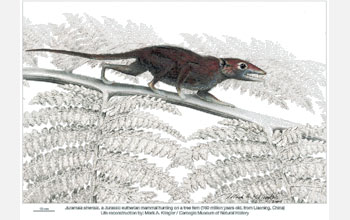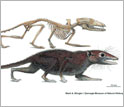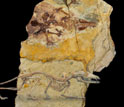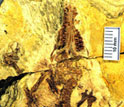News Release 11-171
Fossil Discovery Represents New Milestone in Early Mammal Evolution
Northeast China fossil provides new information about earliest ancestors of today's mammals

Life restoration of the nocturnal mammal Juramaia, hunting insects on a tree fern.
August 24, 2011
This material is available primarily for archival purposes. Telephone numbers or other contact information may be out of date; please see current contact information at media contacts.
A well-preserved fossil discovered in northeast China provides new information about the earliest ancestors of most of today's mammal species--the placental mammals.
According to a paper published today in the journal Nature, the fossil represents a new milestone in mammal evolution that was reached 35 million years earlier than previously thought.
It fills an important gap in the fossil record and helps to calibrate modern, DNA-based methods of dating evolution.
The paper, by a team of scientists led by Carnegie Museum of Natural History paleontologist Zhe-Xi Luo, describes Juramaia sinensis, a small shrew-like mammal that lived in China 160 million years ago during the Jurassic.
Juramaia is the earliest known fossil of eutherians--the group that evolved to include all placental mammals, which provide nourishment to unborn young via a placenta.
As the earliest known fossil ancestor to placental mammals, Juramaia provides fossil evidence of the date when eutherian mammals diverged from other mammals: metatherians (whose descendants include marsupials such as kangaroos) and monotremes (such as the platypus).
As Luo explains, "Juramaia, from 160 million years ago, is either a great-grand-aunt or a great-grandmother of all placental mammals that are thriving today."
The fossil of Juramaia sinensis was discovered in the Liaoning Province in northeast China and examined in Beijing by Luo and collaborators: Chong-Xi Yuan and Qiang Ji from the Chinese Academy of Geological Sciences and Qing-Jin Meng from the Beijing Museum of Natural History, where the fossil is stored.
The name Juramaia sinensis means "Jurassic mother from China."
The fossil has an incomplete skull, part of the skeleton, and, remarkably, impressions of residual soft tissues such as hair.
Juramaia's complete teeth and forepaw bones enable paleontologists to pinpoint that it is closer to living placentals on the mammalian family tree than to the pouched marsupials, such as kangaroos.
"Understanding the beginning point of placentals is a crucial issue in the study of all mammalian evolution," says Luo.
Modern molecular studies, such as DNA-based methods, can calculate the timing of evolution by a "molecular clock."
But the molecular clock needs to be cross-checked and tested by the fossil record.
Prior to the discovery of Juramaia, the divergence of eutherians from metatherians posed a quandary for evolutionary biologists: DNA evidence suggested that eutherians should have shown up earlier in the fossil record--around 160 million years ago.
The oldest known eutherian was Eomaia, dated to 125 million years ago. (Eomaia was originally described in 2002 by a team of scientists led by Luo and Carnegie mammalogist John Wible.)
The discovery of Juramaia provides much earlier fossil evidence to corroborate the DNA findings, filling an important gap in the fossil record of early mammal evolution and helping to establish a new milestone of evolutionary history.
"These scientists have used the rich fossil mammal record to test evolutionary hypotheses proposed by their colleagues studying living mammals using genetic data," says Chuck Lydeard, program director in the National Science Foundation's NSF) Division of Environmental Biology, which co-funded the research with NSF's Division of Earth Sciences.
Juramaia also reveals adaptive features that may have helped the eutherian newcomers survive in a tough Jurassic environment.
Juramaia's forelimbs are adapted for climbing. Since the majority of Jurassic mammals lived exclusively on the ground, the ability to escape to the trees and explore the canopy might have allowed eutherian mammals to exploit an untapped niche.
Luo supports this perspective: "The divergence of eutherian mammals from marsupials eventually led to the placental birth and reproduction that are so crucial for the evolutionary success of placentals.
"But it is their early adaptation to exploit niches on trees that paved their way toward this success."
-NSF-
-
The new Jurassic mammal is shrew-sized, with a skull 22 millimeters (~3/4 of an inch) long.
Credit and Larger Version -
Photographic collage of the fossil and restorations of Juramaia.
Credit and Larger Version -
The fossil is preserved on a shale slab; it belongs to the Beijing Museum of Natural History.
Credit and Larger Version -
The fossil site where Juramaia was discovered, northeast of Beijing, China.
Credit and Larger Version
Media Contacts
Cheryl Dybas, NSF, (703) 292-7734, email: cdybas@nsf.gov
Leigh Kish, Carnegie Museum of Natural History, (412) 622-3361, email: kishl@carnegiemnh.org
The U.S. National Science Foundation propels the nation forward by advancing fundamental research in all fields of science and engineering. NSF supports research and people by providing facilities, instruments and funding to support their ingenuity and sustain the U.S. as a global leader in research and innovation. With a fiscal year 2023 budget of $9.5 billion, NSF funds reach all 50 states through grants to nearly 2,000 colleges, universities and institutions. Each year, NSF receives more than 40,000 competitive proposals and makes about 11,000 new awards. Those awards include support for cooperative research with industry, Arctic and Antarctic research and operations, and U.S. participation in international scientific efforts.
Connect with us online
NSF website: nsf.gov
NSF News: nsf.gov/news
For News Media: nsf.gov/news/newsroom
Statistics: nsf.gov/statistics/
Awards database: nsf.gov/awardsearch/
Follow us on social
Twitter: twitter.com/NSF
Facebook: facebook.com/US.NSF
Instagram: instagram.com/nsfgov




